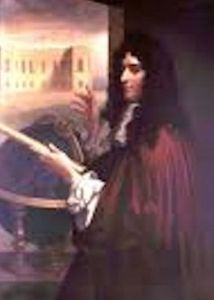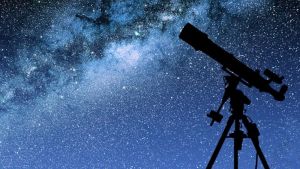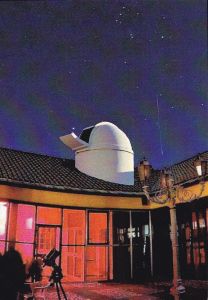Astrologer and Astronomer
His life and knowledge
 Giandomenico Cassini was born in Perinaldo on 8 June 1625, the first of four generations of astronomers. Son of Giacomo Cassini, a small landowner, and of Tullia Crovese, belonging to a rich family of notaries from Perinaldo, then land of the Marquises Doria, in the County of Nice.
Giandomenico Cassini was born in Perinaldo on 8 June 1625, the first of four generations of astronomers. Son of Giacomo Cassini, a small landowner, and of Tullia Crovese, belonging to a rich family of notaries from Perinaldo, then land of the Marquises Doria, in the County of Nice.
He received his first education from a maternal uncle and was then sent to the school of Father Giovanni Francesco Aprosio in Vallebona, in the immediate hinterland of Bordighera, where he remained for two years.
In 1638 he left for Genoa to enter the prestigious Jesuit College, where he completed his studies. In 1649 he left Genoa for Bologna, where at the age of 25 he obtained the chair of astronomy at the prestigious University. In Bologna he spent 20 years of intense study and research, dedicating himself to the study of comets, those of 1652 and 1664; to the study of the Sun, building the Sundial in the Basilica of San Petronio, which allowed him to calculate the exact length of the tropical year, to verify the disuniformity of the apparent motion of the Sun, to calculate the obliquity of the ecliptic, to define precise Refraction Tables; he observes Mars, Jupiter and Venus whose rotation times he establishes; he calculates with exactitude the moments of the eclipses of Jupiter's satellites, publishing in 1668 the "Tables of their ephemerides", fundamental for the determination of longitude and which can be considered his passport to France.
In Bologna he spent 20 years of intense study and research, dedicating himself to the study of comets, those of 1652 and 1664; to the study of the Sun, building the Sundial in the Basilica of San Petronio, which allowed him to calculate the exact length of the tropical year, to verify the disuniformity of the apparent motion of the Sun, to calculate the obliquity of the ecliptic, to define precise Refraction Tables; he observes Mars, Jupiter and Venus whose rotation times he establishes; he calculates with exactitude the moments of the eclipses of Jupiter's satellites, publishing in 1668 the "Tables of their ephemerides", fundamental for the determination of longitude and which can be considered his passport to France.
Called by Colbert, Louis XIV's minister, he arrived in Paris on 4 April 1669 and remained there for the rest of his life.
 In Paris, on 14 September 1671 he entered the Observatoire: from that day on he scrupulously recorded all his observations in a personal "Journal", of which he then gave an account to the Académie des Sciences, of which he was a member.
In Paris, on 14 September 1671 he entered the Observatoire: from that day on he scrupulously recorded all his observations in a personal "Journal", of which he then gave an account to the Académie des Sciences, of which he was a member.
He studied the sunspots, the eclipses of the Moon and the Sun; he organised expeditions to various parts of the world for coordinated observations, he still observed Jupiter and its spots; Mars, of which he calculated the parallax, which allowed him to determine the distance Earth-Sun and therefore that of all the planets; he still observes comets, in 1681-82, he discovers the zodiacal light; he makes a very detailed map of the Moon; but more specifically he deals with Saturn, of which he discovers four new satellites, two in 1671-72 and two in 1684, its rings, and the division between the rings, still called Cassini Division.
In 1694 he left for Italy, in the company of his son Jacques, for the restoration of the San Petronio Sundial, and returned to Perinaldo; here too, as in every city where they found themselves passing, they made observations, from the house where they were born and from various places, among which, it seems, the "Torre dell'Alpicella", a small hill not far from the village. They returned to Paris in 1696.
Then, in the last years of his life, he was about to do a gigantic work: the systematic survey of the whole French territory, using at the same time the system of triangulations and his method of determining longitude, to draw the new Map of France, wanted by the King; Cassini began the work with Picard and continued it with his son Jacques; but the great work was completed after almost 130 years by his descendants, Cassini III of Thury and Cassini IV.
Giandomenico Cassini died on 14 September 1712 in Paris and was buried in Saint Jacques du Haut-Pas, the Parish of the Observatoire.
(taken from notes by Anna Cassini)
There are traces of Cassini's passages in Sanremo, a city that held him in high esteem by naming the Liceo-Ginnasio in 1860 and the square in front of the Church of the Jesuit PP.
In modernity the name of Cassini has been used several times and the most striking example was the:
Cassini - Huygens Space Mission
Cassini-Huygens was a joint NASA/ESA/ASI interplanetary robotic mission launched on 15 October 1997 to study the Saturn system, including its moons and rings.  The probe consisted of two elements: NASA's Cassini orbiter and ESA's Huygens lander.
The probe consisted of two elements: NASA's Cassini orbiter and ESA's Huygens lander.
The probe concluded its mission with its "grand finale" on 15 September 2017 after, as planned, it was returned to Saturn's atmosphere and thus disintegrated. The probe was destroyed at about 10:31 UTC and the last signal was received at 11:55 UTC.[1]
Cassini was the first probe to enter Saturn's orbit on 1 July 2004 (04:12 GMT), and only the fourth to have visited it (Pioneer 11 and Voyager 1 and 2 had already passed before Cassini).
On 25 December 2004 the Huygens spacecraft separated from the mother ship and headed towards Saturn's main moon, Titan.
On January 14, 2005 Huygens descended into the satellite's atmosphere and during the run collected atmospheric data, surface images, noise from the surrounding environment. It touched the ground after a descent of 2 h and 30 m and then continued to transmit its signal for another 90 minutes.
The Cassini orbiter takes its name from the Italian astronomer Giovanni Domenico Cassini who, towards the end of the seventeenth century, played a major role in the study of Saturn and its rings. The Huygens lander takes its name from the 17th century Dutch astronomer Christiaan Huygens who, using his telescope, discovered Titan.
(From Wikipedia, the free encyclopedia)
Astronomical Observatory In Perinaldo, not far from Sanremo, the astronomer's birthplace, an astronomical observatory in the name of his illustrious son has been created over twenty years ago and recently renovated. Since 1997 it has been run by the Associazione Stellaria, which since its foundation has been almost amateur astronomers' observatory, whose structures and equipment at the time still consisted of a mirror on the roof of the town hall building and a 380 mm Newtonian reflector telescope. Thanks to the tenacity and willingness of the members, the development of the Observatory has been increased, collaborating also with international space agencies until reaching the possibility of considerably enriching the instrumental patrimony of the Observatory of the Municipality of Perinaldo (new telescopes, Planetarium..), creating and equipping new observation spaces (a new observation station), renovating and updating the Cassini Museum, creating astronomical routes in Perinaldo and outside, creating original and innovative instruments in the field of astronomical divulgation.
In Perinaldo, not far from Sanremo, the astronomer's birthplace, an astronomical observatory in the name of his illustrious son has been created over twenty years ago and recently renovated. Since 1997 it has been run by the Associazione Stellaria, which since its foundation has been almost amateur astronomers' observatory, whose structures and equipment at the time still consisted of a mirror on the roof of the town hall building and a 380 mm Newtonian reflector telescope. Thanks to the tenacity and willingness of the members, the development of the Observatory has been increased, collaborating also with international space agencies until reaching the possibility of considerably enriching the instrumental patrimony of the Observatory of the Municipality of Perinaldo (new telescopes, Planetarium..), creating and equipping new observation spaces (a new observation station), renovating and updating the Cassini Museum, creating astronomical routes in Perinaldo and outside, creating original and innovative instruments in the field of astronomical divulgation.
(Notes by the Stellar Association)




